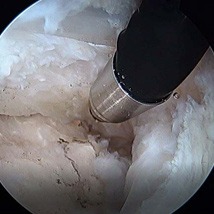Lateral Hip Anatomy
The lateral hip is composed of muscles, tendons, and bursal sacs that overlay and attach to the bony prominence on the outside of the hip (greater trochanter).
The gluteus medius and minimus are muscles located on the outside of the hip. They are also called the “rotator cuff of the hip.” They form tendons that attach to the lateral hip and are essential for normal walking allowing your leg to swing to the side away from your body.
The iliotibial band (IT band) is a large band formed from two muscles that span the outside part of the thigh and run down to the outside of the knee. The trochanteric bursa overlies the greater trochanter and provides a cushion for the IT band and gluteus medius.
What is Greater Trochanteric Pain Syndrome (GTPS)?
Lateral hip pain and dysfunction caused by:
- Trochanteric Bursitis
- Gluteus Medius Tears
- Snapping Hip
GTPS can be caused by any or all of these conditions and there is often overlap. It is important to see a hip preservation specialist to accurately diagnose this condition as misdiagnosis can lead to delay in appropriate treatment and continued pain and dysfunction.
Trochanteric bursitis
This is inflammation in the bursa caused by injury or overuse. Patients typically complain of pain on the outside of the hip and thigh with direct pressure on the outside of the hip (i.e. sleeping on the side) and pain when standing for a long time.
Gluteus Medius Tears
Gluteus medius tears are increasingly recognized as a cause of GTPS with 25% of middle-aged women. Tears can occur due to an acute injury or can result from repetitive stress and overuse. Patients present with pain on the outside of the hip with sleep, standing, and going up and down stairs. Larger tears can lead to a limp due to weakness caused by the tear.
Snapping Hip
This condition is caused by the thickening of the back part of the IT band. The IT band then snaps across the bony prominence (greater trochanter) on the outside of the hip when moving your hip up and down. Often we can see the IT band snap but can’t hear it. Bringing the leg across your body also causes pain and tightness.
GTPS Treatment
Not all patients with GTPS need surgery. Trochanteric bursitis and snapping hip often improve with non-operative treatment. Surgery is necessary for large gluteus medius tears and smaller tears that fail non-operative treatment.
Non-operative Treatment for GTPS
Non-operative treatment is used in trochanteric bursitis, snapping hip, and small gluteus medius tears. Rest, avoiding painful activities, and anti-inflammatory medications (Advil, Aleve, etc.) can often improve symptoms. Physical therapy can help improve pain and function. Ultrasound-guided cortisone or PRP injections can also be used to decrease pain and inflammation.
Operative Treatment for GTPS
Surgery is typically necessary for large gluteus medius tears or small tears that have not improved with non-operative treatment.
Minimally invasive surgery can be performed either through one small incision in the lateral hip or through 3-4 poke-hole incisions with the use of a camera and special instruments. The damaged trochanteric bursa is removed. The tendons are reattached to the lateral hip (greater trochanter) with suture anchors.
Patients return home the same day after surgery. Patients are on crutches for 6-8 weeks. Full recovery takes 5 to 6 months and requires physical therapy to restore optimal hip and knee function.



